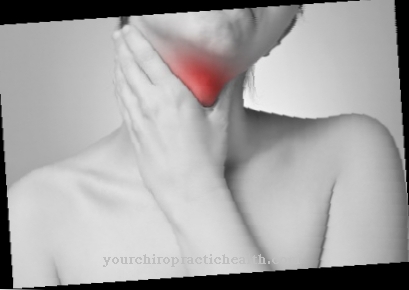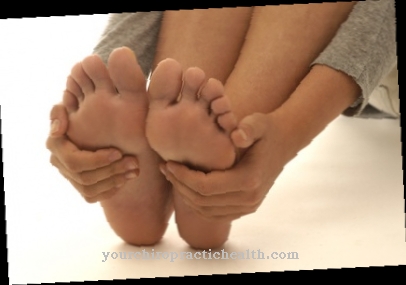A Cardiac arrhythmia or Palpitations is a disturbance of the normal heartbeat sequence, caused by irregular processes in the formation and conduction of excitation in the heart muscle. Cardiac arrhythmias are quite common. An adult's heart beats an average of one hundred thousand times a day. The fact that the heart beats faster or slower from time to time is basically normal and not necessarily pathological. However, frequent cardiac arrhythmias that may occur over a longer period of time should be examined by a doctor.
What are arrhythmias?

In the case of cardiac arrhythmias, the heart rate can either be increased (over 100 beats per minute), slowed down (below 60 beats per minute), interrupted or stumbled. These signs do not have to be pathological either. Endurance athletes usually have a pronounced calm pulse (resting pulse), which can be quite normal at less than 60 beats per minute.
Cardiac arrhythmias are common. Healthy people sometimes notice a stumbling of the heart (palpitations), extra heartbeats (extrasystoles), or brief stopping of the heartbeat caused by extra beats. Often you don't even feel the cardiac arrhythmias.
Palpitations, like rapid atrial fibrillation, are often described as regular or irregular palpitations up to the throat. If a heart is already damaged, an existing heart failure can worsen due to the high heart rate.
This can be expressed, for example, by shortness of breath. In severe cases, pulmonary edema can result. Heart pain (angina pectoris) can also occur as well as a deterioration in cerebral blood flow (dizziness, seizures, disorientation, temporary speech and vision disorders).
Dangerous cardiac arrhythmias (e.g. ventricular tachycardia) can severely limit the cardiac output so that adequate circulation is no longer possible. The patients lose consciousness. Mechanical malfunctions are present in ventricular flutter or fibrillation with cardiac arrest (asystole). If these cardiac arrhythmias occur for no apparent reason, one speaks of sudden cardiac death.
causes
As noted above, the causes of cardiac arrhythmias do not have to be of a pathological nature.
Pathological cardiac arrhythmias are usually damage to the sinus node (the natural pacemaker of the heart) or the conduction system. Typical diseases associated with cardiac arrhythmias are e.g. Coronary artery disease, valvular heart disease, heart muscle disease, or an overactive thyroid.
As with a racing heart, a too fast (tachycardiac) heartbeat can occur due to stress, caffeine, excitement, stress and smoking.
You can find your medication here
➔ Medicines for cardiac arrhythmiasDiseases with this symptom
- Coronary heart disease
- Heart attack
- Pulmonary embolism
- AV block
- Obesity
- Diabetes mellitus
- Acidosis
- Kidney weakness
- Myocarditis
- Ventricular fibrillation
- Hyperthyroidism
- bulimia
Complications
Cardiac arrhythmias can cause life-threatening complications, especially if the heart is previously damaged due to a previous illness such as endocarditis or heart valve disease. Cardiac arrhythmias can occur in a healthy heart and are usually not even noticed by the person affected; this often manifests as extrasystole on the ECG.
Healthy people may experience dizziness, shortness of breath or short-term fainting (syncope), but no other more serious complications. In the previously damaged heart, arrhythmias can cause some dangerous complications. For example, atrial fibrillation is a possible cardiac arrhythmia, a disorder of the atrial excitation, so that an irregular, rapid pulse occurs.
In this case, blood clots can form in the atrium, which can detach from the wall due to the irregular beat of the atrium and be transported further with the blood stream. In doing so, they easily reach important vessels in the brain and can thus trigger a stroke that can lead to death.
In addition to a stroke, blood flow to the heart is at risk due to the irregular, fast heartbeat. This can lead to an insufficient supply of oxygen to the heart and subsequently to a heart attack and, if left untreated, to cardiac death. Another dangerous form of cardiac arrhythmia is ventricular fibrillation, which, without treatment by defibrillation, can quickly lead to cardiac arrest and thus also to cardiac death.
Diagnosis & course
In the case of cardiac arrhythmias, targeted diagnostics can determine, among other things, whether the corresponding disorders require medical treatment.
In the course of the diagnosis, the doctor usually first asks about the individual medical history and any previous or concomitant illnesses. Physical examinations that follow include, for example, measuring your heart rate and listening to your heart. Depending on the suspected cause of the present cardiac arrhythmia, the ECG, ultrasound and X-ray examinations as well as blood analyzes can also be diagnostically useful.
The course of cardiac arrhythmias is primarily dependent on their severity and cause (s) - pathological cardiac arrhythmias can, if left untreated, reduce the quality of life and shorten the lifespan. Cardiac arrhythmias without any disease value are often harmless.
When should you go to the doctor?
Cardiac arrhythmia is a disorder of the usual heartbeat sequence. At the same time, the terms cardiac stumbling and arrhythmia are also used. Cardiac arrhythmias can also occur in healthy people, especially after exertion or excitement. Cardiac arrhythmias manifest themselves as irregular heartbeats, additional heartbeats or a brief stopping of the heartbeat.However, if cardiac arrhythmias occur more frequently and a triggering cause is not always known, they should be clarified by a doctor.
The family doctor is the first point of contact to diagnose a possible cause of cardiac arrhythmias. On the basis of a detailed anamnesis, he can estimate whether there is a suspicion of a heart disease. For further diagnostics, he will consult a specialist such as the cardiologist. A pulmonologist or neurologist may also be considered. If the heartbeat is fast, it may be atrial fibrillation. Even a weakened heart can beat too quickly and that alone can make it worse.
In addition to other various heart diseases, cardiac arrhythmias can be based on pulmonary edema and a poorly supplied brain. Since cardiac arrhythmias are potentially life-threatening, a visit to the doctor should not be delayed too long. If necessary, a hospital stay for inpatient intensive clarification of the cardiac arrhythmia can also be useful.
Doctors & therapists in your area
Treatment & Therapy

Arrhythmias should always be examined by a doctor. With the help of various examinations, this determines whether the cardiac arrhythmias are harmless or serious.
The first thing to do is to talk to the patient in order to identify symptoms and possible previous illnesses. The doctor then usually measures the pulse and heart rate and creates an electrocardiogram (EKG), which can also be used in the form of a long-term EKG or stress EKG. The ultrasound examination of the heart (echocardiography), blood tests and x-rays also provide further information about the status of the arrhythmia.
The following treatment of the cardiac arrhythmias depends on their cause. The top priority is that the symptoms of cardiac arrhythmias are treated and dangers or complications from the heart are eliminated. Drugs such as antiarrhythmics change the conduction of the heart through their effects.
In the case of cardiac arrhythmias, the therapy depends on their type and cause. The aim of treatment is on the one hand to alleviate the symptoms and on the other hand to avoid the risk of complications (e.g. sudden cardiac death). Cardiac arrhythmias can be treated with antiarrhythmics, among other things. Antiarrhythmics change the conduction of the heart in various ways.
In rare cases, the use of a pacemaker must also be considered. In some cases the implantation of a pacemaker is advisable in the case of cardiac arrhythmias caused by illness.
If psychological stress such as stress is the cause, relaxation measures and stress avoidance are recommended. Autogenic training is particularly promising here.
Outlook & forecast
The multitude of different cardiac arrhythmias that affect either the atria or the ventricles are linked to the fact that either the electrical excitation, which is supposed to lead to the contraction of the atria and then the ventricles, fails to occur or the transmission is faulty.
The prospect and prognosis of the individual arrhythmias depend largely on the treated or untreated course of the underlying disease. Rather harmless arrhythmias that manifest themselves in individual beats “out of sequence” or in occasional heart stumbling (palpitations) do not require any treatment and the normal rhythm will be restored by itself.
A frequently encountered cardiac arrhythmia is so-called atrial fibrillation, which affects older males more often than women. Atrial fibrillation with a typical beating rate of 140 per minute is not immediately life-threatening, but if left untreated it can lead to irreversible damage to the overloaded heart muscle. Ventricular fibrillation, on the other hand, with a pulse that can no longer be felt by hand, is immediately life-threatening.
The prognosis for cardiac arrhythmias triggered by external factors such as electrolyte imbalances, medication, psycho-vegetative factors, hypoxia and others tends towards self-healing once the external trigger factors have been resolved.
If the causative factors are not known or cannot be remedied, the prognosis is poor. The outlook and prognosis are good if it is possible to restore the heart's normal sinus rhythm, for example through electrical intervention such as electrocardioversion or defibrillation.
You can find your medication here
➔ Medicines for cardiac arrhythmiasprevention
Home remedies ↵ for palpitations Cardiac arrhythmias that are not caused by illness can be prevented by a healthy, stress-free life with lots of exercise, fresh air, a healthy diet and refraining from smoking and alcohol. Autogenic training is also preventative, as it not only serves to calm you down but can also bring more relaxation to everyday life.
You can do that yourself
In the case of severe cardiac arrhythmias, self-help should be avoided. Cardiac arrhythmias represent a very high health risk for the human body and should therefore always be treated by a doctor. A doctor must be consulted urgently, especially if there is severe pain in the heart or chest or if there are convulsive attacks. Surgery is very likely to be necessary here to correct the cardiac arrhythmia. Treatment at home is not possible in this case.
In many cases, cardiac arrhythmias can be corrected with medical treatment, often with a pacemaker. In order to relieve the heart and prevent problems with the heart, the patient should generally pay attention to a healthy diet and exercise. This can prevent many heart problems. The heart should also be examined by a cardiologist at regular intervals, especially in old age. This also prevents consequential damage.
If the arrhythmia occurs suddenly and unexpectedly, an emergency doctor should be called. In the worst case, the arrhythmias can lead to death without treatment. Treatment at home is therefore not provided.
























.jpg)



